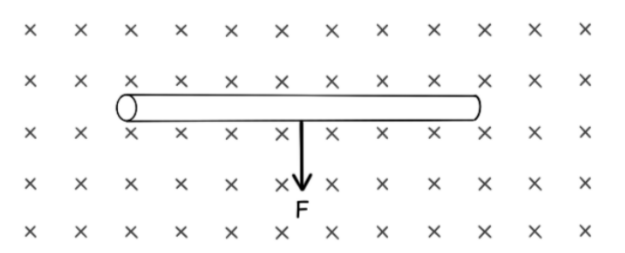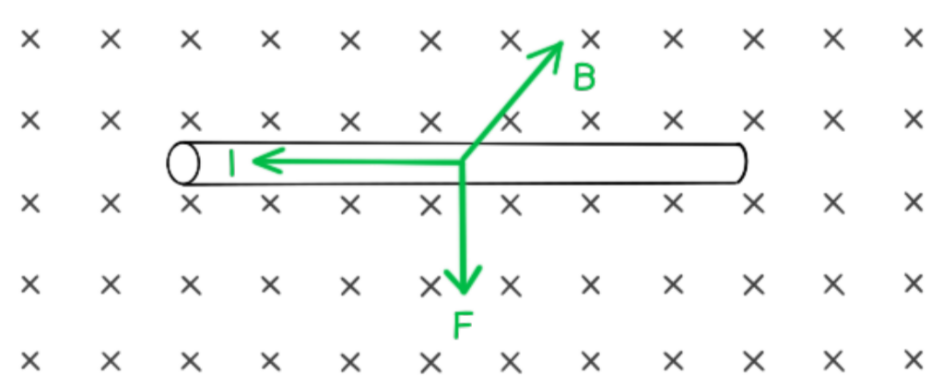FORCE ON A CURRENT-CARRYING CONDUCTOR
Force on a Current-Carrying Conductor
- A current-carrying conductor produces its own magnetic field
- When interacting with an external magnetic field, it will experience a force
- A current-carrying conductor will only experience a force if the current through it is perpendicular to the direction of the magnetic field lines
- A simple situation would be a copper rod placed within a uniform magnetic field
- When current is passed through the copper rod, it experiences a force which makes it move
Calculating Magnetic Force on a Current-Carrying Conductor
- The strength of a magnetic field is known as the magnetic flux density, B
- This is also known as the magnetic field strength
- It is measured in units of Tesla (T)
- The force $F$ on a conductor carrying current $/$ at right angles to a magnetic field with flux density $B$ is defined by the equation
$
F=B I L \sin \theta
$
- Where:
- $F=$ force on a current carrying conductor in a $B$ field (N)
- $B=$ magnetic flux density of external $B$ field $(T)$
- $I=$ current in the conductor $(A)$
- $L=$ length of the conductor $(\mathrm{m})$
- $\theta=$ angle between the conductor and external B field (degrees)
- This equation shows that the greater the current or the magnetic field strength, the greater the force on the conductor
- The maximum force occurs when $\sin \theta=1$
- This means $\theta=90^{\circ}$ and the conductor is perpendicular to the $B$ field
- This equation for the magnetic force now becomes:
$
\mathbf{F}=\mathbf{B I L}
$
- The minimum force $(0)$ is when $\sin \theta=0$
- This means $\theta=0^{\circ}$ and the conductor is parallel to the $B$ field
- It is important to note that a current-carrying conductor will experience no force in a magnetic field if is parallel to the field
Worked example
A current of $0.87 \mathrm{~A}$ flows in a wire of length $1.4 \mathrm{~m}$ placed at $30^{\circ}$ to a magnetic field of flux density $80 \mathrm{mT}$.
Calculate the force on the wire.
Answer/Explanation
Step 1:
Write down the known quantities
Magnetic flux density, $B=80 \mathrm{mT}=80 \times 10^{-3} \mathrm{~T}$
Current, $I=0.87$
Length of wire, $\mathrm{L}=1.4 \mathrm{~m}$
Angle between the wire and the magnetic field, $\theta=30^{\circ}$
Step 2: Write down the equation for force on a current-carrying conductor
$
F=B I L \sin \theta
$
Step 3: $\quad$ Substitute in values and calculate
$
F=\left(80 \times 10^{-3}\right) \times(0.87) \times(1.4) \times \sin (30)=0.04872=0.049 N(2 \text { s.f })
$
Exam Tip
Remember that the direction of current flow is the flow of positive charge (positive to negative), and this is in the opposite direction to the flow of electrons
FLEMING’S LEFT-HAND RULE
Fleming’s Left-Hand Rule
- The direction of the force on a charge moving in a magnetic field is determined by the direction of the magnetic field and the current
- Recall that the direction of the current is the direction of conventional current flow (positive to negative)
- When the force, magnetic field and current are all mutually perpendicular to each other, the directions of each can be interpreted by Fleming’s left-hand rule:
- On the left hand, with the thumb pointed upwards, first finger forwards and second finger to the right ie. all three are perpendicular to each other
- The thumb points in the direction of motion of the rod (or the direction of the force) $(F)$
- The first finger points in the direction of the external magnetic field $(B)$
- The second finger points in the direction of conventional current flow (I)
Worked example: Using the left-hand rule
State the direction of the current flowing in the wire in the diagram below.

Using Fleming’s left-hand rule:
$B=$ into the page
$\mathbf{F}=$ vertically downwards
$I$ = from right to left

Exam Tip
Don’t be afraid to use Fleming’s left-hand rule during an exam. Although, it is best to do it subtly in order not to give the answer away to other students!
MAGNETIC FLUX DENSITY
Magnetic Flux Density Definition
- The magnetic flux density $B$ is defined as:
The force acting per unit current per unit length on a current-carrying conductor placed perpendicular to the magnetic field - Rearranging the equation for magnetic force on a wire, the magnetic flux density is defined by the equation:
$
\mathrm{B}=\frac{F}{I L}
$
- Note: this equation is only relevant when the B field is perpendicular to the current
- Magnetic flux density is measured in units of tesla, which is defined as:
A straight conductor carrying a current of $1 \mathrm{~A}$ normal to a magnetic field of flux density of $1 \mathrm{~T}$ with force per unit length of the conductor of $1 \mathrm{~N} \mathrm{~m}^{-1}$ - To put this into perspective, the Earth’s magnetic flux density is around $0.032 \mathrm{mT}$ and an ordinary fridge magnet is around $5 \mathrm{mT}$
Worked example: Calculating flux density
A $15 \mathrm{~cm}$ length of wire is placed vertically and at right angles to a magnetic field. When a current of $3.0 \mathrm{~A}$ flows in the wire vertically upwards, a force of $0.04 \mathrm{~N}$ acts on it to the left. Determine the flux density of the field and its direction.
Answer/Explanation
Step 1:
Write out the known quantities
Force on wire, $\mathrm{F}=0.04 \mathrm{~N}$
Current, $I=3.0 \mathrm{~A}$
Length of wire $=15 \mathrm{~cm}=15 \times 10^{-2} \mathrm{~m}$
Step 2:
Magnetic flux density $B$ equation
$$
\mathrm{B}=\frac{F}{I L}
$$
Step 3:
Substitute in values
$$
B=\frac{0.04}{3 \times 15 \times 10^{-2}}=0.089 \mathrm{~T}(2 \mathrm{~s} . \mathrm{f})
$$
Step 4:
Determine the direction of the $B$ field
Using Fleming’s left-hand rule :
$F=$ to the left
$I=$ vertically upwards
therefore, $B=$ into the page
